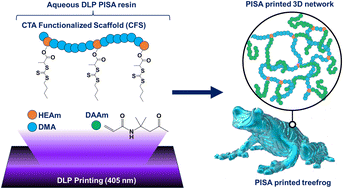RSC Applied Polymers has published its first articles. To celebrate this we wish to introduce some of our #RSCAppliedfirst50 authors and their recently published articles.
In this post we feature an introduction to ‘PISA printing from CTA functionalized polymer scaffolds’ written by Dr Anthony Convertine.
An Introduction to ‘PISA printing from CTA functionalized polymer scaffolds’ by Dr. Anthony Convertine
Dr. Anthony Convertine and his research team at Missouri University of Science and Technology are developing a new 3D printing technique known as PISA Printing, as detailed in their publication “PISA printing from CTA functionalized polymer scaffolds” in RSC Applied Polymers. This method combines Polymerization-Induced Self-Assembly (PISA) with controlled RAFT polymerization to create complex, high-resolution structures from biocompatible materials. The technique allows for the production of scaffolds that can replicate the detailed architecture of vascular tissues, achieving resolutions around 22 microns. With ongoing efforts to improve the diversity of materials used and the precision of the printing process, their research aims to enhance the capabilities of tissue engineering, potentially offering new avenues for medical treatments and regenerative medicine.
In our recent publication, “PISA printing from CTA functionalized polymer scaffolds,” we explore the application of Polymerization-Induced Self-Assembly (PISA) printing within the realm of 3D printing technology.. The paper outlines how Controlled Radical Polymerization, particularly RAFT polymerization, can be integrated with DLP printers to fabricate detailed, high-resolution biomedical scaffolds. Our findings reveal that PISA printing can create intricate structures, essential for replicating the complex microenvironment of natural tissues.
Polymers are crucial in this process, acting as the base material for printing these structures. We utilize Chain Transfer Agent (CTA) functionalized polymers to enable the self-assembly of nanostructures into solid forms, bypassing the need for traditional chemical crosslinking. This approach not only streamlines the manufacturing process but also produces materials that are both biocompatible and capable of controlled degradation within the body.
A notable achievement of our research is reaching printing resolutions of up to 22 microns, a significant advancement for tissue engineering efforts that require the precise replication of vascular networks. Furthermore, our study emphasizes the critical role of multifunctional CTA design in improving the mechanical strength of the printed scaffolds, thereby supporting cellular growth and tissue development.
Looking ahead, our team is committed to enhancing the PISA printing technique by investigating a broader selection of polymers and functionalization methods to boost scaffold functionality. We’re also aiming to extend the use of PISA printing to the creation of organ-specific scaffolds, seeking collaborations with stem cell and organ modelling specialists to achieve these ambitious objectives.

Dr Anthony Convertine
Behind this research is Dr. Anthony Convertine, the Roberta and G. Robert Couch Assistant Professor at Missouri University of Science and Technology. He earned his Ph.D. in Polymer Science and Engineering from the University of Southern Mississippi under the advisement of Professor Charles McCormick, specializing in controlled RAFT polymerization. He then moved to the University of Washington where he conducted postdoctoral research under Professors Patrick Stayton and Allan Hoffman in the department of Bioengineering. The focus of his postdoctoral studies was to develop pH-responsive polymers to facilitate the intracellular delivery of biologic drugs (i.e. siRNA, mRNA, peptides, antibodies).
PISA printing from CTA functionalized polymer scaffolds
A. Priester, J. Yeng, Y. Zhang, R. Wang and A. J. Convertine
RSC Appl. Polym., 2024, Advance Article.
 |
RSC Applied Polymers is a leading international journal for the application of polymers, including experimental and computational studies on both natural and synthetic systems. In this journal, you can discover cross-disciplinary scientific research that leverages polymeric materials in a range of applications. This includes high impact advances made possible with polymers across materials, biology, energy applications and beyond. |



